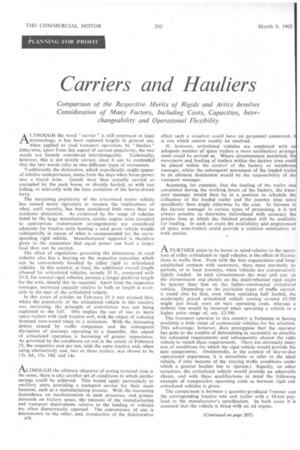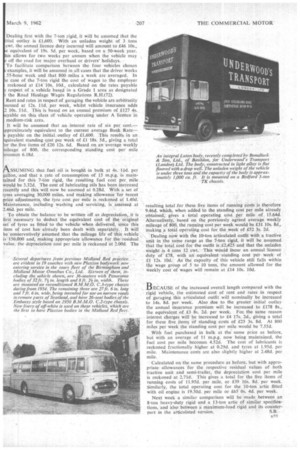Carriers and Hauliers
Page 90

Page 93

If you've noticed an error in this article please click here to report it so we can fix it.
Comparison of the Respective Merits of Rigids and Artics Involves Consideration of Many Factors, Including Costs, Capacities, Interchangeability and Operational Flexibility ALTHOUGH the word " carrier is still employed in legal terminology, it has been replaced largely in general use, when applied to road transport operation, by " haulier." Otherwise, apart from this aspect of current popularity, the two words are loosely considered interchangeable. Technically, however, this is not strictly correct, since it can be contended that the two words refer to two different types of movement.
Traditionally the distinction, which superficially might appear of relative unimportance, stems from the days when horse-power was a literal term, Goods were then actually carried as exampled by the pack horse, or directly hauled, as with tree felling, or indirectly with the later evolution of the horse-drawn lorry.
The increasing popularity of the articulated motor vehicle has caused many operators to reassess the implications of what, until recently, has been considered little more than an academic distinction. As evidenced by the range of vehicles listed by the large manufacturers, similar engine units (coupled to appropriate transmission arrangements) are considered adequate for tractive units hauling a total gross vehicle weight substantially in excess of what is recommended for the corresponding rigid vehicle. Manufacturers' approval is therefore given to the contention that equal power can haul a larger load than can be carried.
The effect of regulations governing the dimensions of road vehicles also has a bearing on the respective capacities which can be conveniently handled by either rigid or articulated vehicles. In this country, at least, the additional overall length allowed for articulated vehicles, namely 35 ft., compared with 30 ft. for normal rigid vehicles, permits a longer platform length for the artic, should this be required. Apart from the respective tonnages, increased capacity relative to bulk or length is available to the user of the articulated vehicle.
In this series of articles on February 23 it was stressed that, whilst the popularity of the articulated vehicle in this country was increasing, the •principle of articulation was not being exploited to the full. This implies the use of one or more spare trailers with each tractive unit, with the object of reducing terminal turn-round times to a minimum. With the increasing delays caused by traffic congestion and the subsequent disruption of journeys operating to a timetable, this aspect of articulated operation is becoming of greater importance. As governed by the conditions set out in the article of February 23, the respective cost per ton, with the same tractive unit, when using alternatively one, two or three trailers, was shown to be 17s. 6d., 15s. 10d. and 145.
ALTHOUGH the ultimate objective of saving terminal time is the same, there is also another set of conditions in which similar savings could be achieved. This would apply particularly to ancillary users providing a transport service for their main business, such as a manufacturing process. With the increasing dependence on mechanization in such processes, and greater demands on factory space, the interests of the manufacturing and transport departments relative to the loading of vehicles are often diametrically opposed. The convenience of one is uneconomic to the other, and, irrespective of the deteriorative
n56 effect such a situation could have on personnel concerned, i is one which cannot readily be resolved.
If, however, articulated vehicles are employed with a adequate number of spare trailers a more satisfactory arrange
ment could be arrived at. Where circumstances permitted, th movement and loading of trailers within the factory area coul be placed within the control of the factory or warehous manager, whilst the subsequent movement of the loaded trailer to its ultimate destination would be the responsibility of the transport manager.
Assuming, for example, that the loading of the trailer was completed during the working hours of the factory, the transport manager would then be in a position to schedule the collection of the loaded trailer and the journey time more specifically than might otherwise be the case. In fairness to the factory manager in certain types of processing, it is not always possible to determine beforehand with accuracy the precise time at which the finished product will he available for loading, In such an event the availability and employment of spare semi-trailers could provide a solution satisfactory to both parties.
AFURTHER point to be borne in mind relative to the-operation of either articulated or rigid vehicles, is the effect of fluctuations in traffic flow. Even with the best organization and longestablished contacts with customers, there must inevitably be periods, or at least journeys, when vehicles are comparatively lightly loaded. In such circumstances the wear and tear on the transmission and chassis on the multi-wheeled rigid might be heavier than that on the lighter-constructed articulated vehicle. Depending on the particular types of traffic carried, it could also be that, even when operating half loaded, the moderately priced articulated vehicle costing around £2,500 might just break even on bare operating costs, whereas a definite loss would be incurred when operating a vehicle in a higher price range of, say, £3.500.
The transport operator in this country is fortunate in having available a wide range of commercial vehicles for his selection. This advantage, however, does presuppose that the operator has gone to the trouble of determining as accurately as possible his estimated requirements and subsequently chosen the right vehicle to match these requirements. There are obviously many sets of conditions for which the rigid vehicle would provide the best compromise. (Incidentally, in the context of day-to-day operational experience, it is unrealistic to refer to the ideal vehicle, if only because of the varying traffic conditions under which a general haulier has to operate.) Equally, on other occasions, the articulated vehicle would provide an admirable choice. and with these qualifications in mind the following example of comparative operating costs as between rigid and articulated vehicles is given.
The comparison is between .a quantity-produced 7-tonner and the corresponding tractive unit and trailer with a 10-ton payload to the manufacturer's specification. In both cases it is assumed that the vehicle is fitted with an oil engine.
Dealing first with the 7-ton rigid, it will he assumed that the itial outlay is £1,600. With an unladen weight of 3 tons cwt. the annual licence duty incurred will amount to £46 10s., e equivalent of 19s. 5d. per week, based on a 50-week year. is allows for two weeks per annum when the vehicle may off the road for major overhaul or drivers' holidays.
To facilitate comparison between the four vehicles chosen examples, it will be assumed in all cases that the driver works 55-hour week and that SOO miles a week are averaged. In e case of the 7-ton rigid the cost of wages to the employer reckoned at £14 10s. 10d., calculated on the rates payable respect of a vehicle based in a Grade 1 area as designated the Road Haulage Wages Regulations R.1-1.(72).
Rent and rates in respect of garaging the vehicle are arbitrarily ssessed at 12s. 11c1, per week, whilst vehicle insurance adds 2 10s. lid. This is based on an annual premium of £127 48. ayabIe on this class Of vehicle operating under A licence in medium-risk area.
It will be assumed that an interest rate of six per cent.pproximately equivalent to the current average Bank Ratepayable on the initial outlay of 11,600. .This results in an quivalent standing cpst per week of £1 1Ss. 5d., giving a total or the five items of £20 12s. 6d. Based on an average weekly ileage of 800, the corresponding standing cost per mile ecomes 6.I8d.
• SSUMING that fuel oil is bought in bulk at 4s. 14d, per allon, and that a rate of consumption of 15 m.p.g. is maintained for this 7-ton rigid, the resulting fuel cost per mile would be 3.32d. The cost of lubricating oils has been increased recently and this will now be assessed at 0.28d. With a set of tyres averaging 30,000 miles, and making allowance 'for recent price adjustments, the tyre cost per mile is reckoned at 1.40d. Maintenance, including washing and servicing, is assessed at 2.46d. per mile.
To obtain the balance to be written off as depreciation, it is first necessary to deduct the equivalent cost of the original set of tyres as fitted to the vehicle when delivered, since this item of cost has already been dealt with separately. It will be conservatively assumed that the mileage life of this vehicle is "150,000 and, making appropriate allowance for the .residual value, the depreciation cost per mile is reckoned at 2.00d. The
• resulting total for these five items of running osts is therefore 9.46d. which, when added to the standing cost per mile already, 'obtained, gives a total operating cost per mile of 15.64d. Alternatively, based on the previously agreed aVerage weekly mileage of 800, the running cost per week would be £31 10s. 8d., making a total operating cost for the week of £52 3s. 2d.
Dealing now with the 10 ton articulated outfit with a tractive unit in the same range as the 7-ton rigid, it will be assumed that the total cost for the outfit is .£2,425 and. that the unladen weight is 4 Ions 12. cwt. This would incur an annual licence duty of 178,. with an .equivalent standing cost per week of 11 12s. 10d. As the capacity of this vehicle still falls within the wage group of 5 to 10 tons, the amount allowed for the Weekly cost of wages will remain at 114 10s. 10d.
BECAUSE of the increased overall length compared with the rigid vehicle, the estimated cost of rent and rates in respect of garaging this articulated outfit will nominally be increased to 14s. 8d. per week. Also due to the greater initial outlay the annual insurance premium will be increased to £178 8s., the equivalent of 13 8s. 2d. per week. For, the same reason interest charges will be increased to £4 17s. 2d., giving a total for these five items of standing costs of £25 3s. 8d. At 800 miles per week the standing cost per mile would be 7.55d.
With fuel purchased in bulk at the same price as before, but with an average of 11 m.p.g. now being maintained, the fuel cost per mile becomes 4.52d. The cost of lubricants is reckoned fractionally higher at 0.29d. and tyres at 1.95d. per mile. Maintenance costs are also slightly higher at 2.48d. per mile.
Calculated on the same procedure as before, but with appropriate allowances for the respective residual values of both tractive unit and semi-trailer, the depreciation cost per mile is reckoned at 2.71d. This gives a total for the five items of running costs of 11.95d. per mile. or £39 16s. 8d. per week. Similarly, the total operating cost for the 10-ton artic fitted with oil engine is 19.50d. per mile or £65 Os. 4d. per week.
Next week a similar comparison will be made between an 8-ton heavy-duty rigid and a 13-ton artic of similar specifidations, and also between a maximum-load rigid and its counter part in the articulated version. S.B.




































































































































